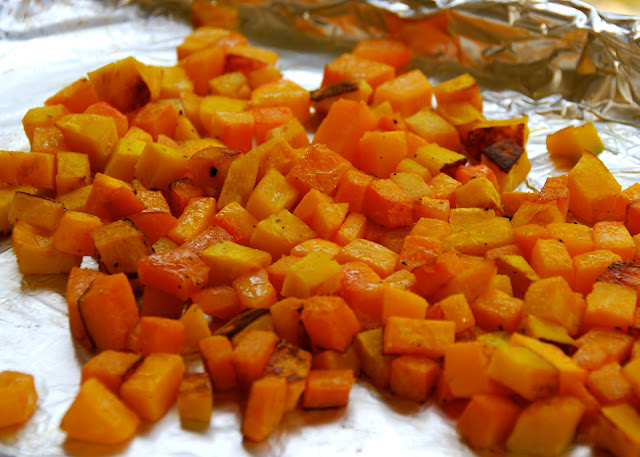Farro with Roasted Squash,
Hazelnuts, Watercress & Goat Cheese
 |
| Farro with Roasted Squash, Hazelnuts, Watercress & Goat Cheese |
Farro is literally the first grain –
the grain from which all grains descended. Tritucum
dicoccum has been growing in the Mediterranean for thousands of years. For
the last few hundred years, farro has been a mainstay of Tuscany. It plays very
well with other fruits of the earth like legumes and leafy vegetables. Since
the outer husk adheres to the grain, the fiber, magnesium and vitamin A, B, C
and E content is very high.
It is not a wheat, but a plant and
grain all its own with low gluten content. It has a complex, nutty taste with
undertones of oats and barley. Because farro contains a starch similar to that
found in Arborio rice, it behaves like risotto, releasing a creamy, binding
liquid when cooked. But unlike risotto, farro does not become gummy; instead,
it retains its tender, distinct bite, even if it sits awhile after cooking.
 |
| Semi-pearled farro |
Farro is sold whole, semi-pearled or
pearled, all of which can be used interchangeably. Pearling removes the
inedible hull that surrounds the grain, but the process also scours off part
(semi-pearled) or all (pearled) of the nutritious germ and bran. Whole farro is
difficult to find in the US. The food world has really been buzzing lately
about farro; its health properties, its wonderful flavor, its texture. While
the pearled is easier and quicker to cook, the nutrients vanish with the husk,
along with a good bit of the flavor. Hence, we much prefer the compromising
semi-pearled farro.
- 2 C Farro, rinsed – semi-pearled preferred
- 2 med. butternut squash, cut into ½-inch cubes (about 3 lbs.)
- 12 C apple cider (divided)
- 4 C water
- ½ C & 3Tb Extra-virgin olive oil (divided)
- ¼ C balsamic vinegar
- ¼ C hazelnuts, toasted
- 2 C cleaned watercress, rinsed & dried
- 8 oz goat cheese
- 1 Tb butter
- Kosher salt
- Freshly ground pepper
Soak the semi-pearled farro 30-60
minutes covered amply by cold water. If using whole farro, soak overnight. Pearled
farro requires no soaking.
To make the vinaigrette, put 8 C apple cider in a saucepan at
med-high heat and reduce down to 1 C. Off heat, add ¼ C balsamic vinegar and whisk together. While continuing whisking,
drizzle in ½ C olive oil to
emulsify. The resulting vinaigrette should be smooth and slightly thick. Set
aside.
 |
| Stirring the vinaigrette (in sepia tones!) |
Start out with 4 C of apple cider and 4 C
water. Add pre-soaked drained farro and season the liquid lightly with salt. Bring
farro to a boil from cold and cook at a steady simmer for 30-40 minutes until
it is slightly al dente. Cooking times will vary depending on the age of the
semi-pearled farro. If using pearled farro, you can expect to cook in half the
time. Taste often as it is cooking, you want it to be toothsome and retain
structure. Drain and add to a large bowl. Add ¼ C of the vinaigrette to the warm
cooked farro and mix thoroughly.
 |
| Cooked farro |
While the farro is cooking, preheat
oven to 450 degree F. Mix cut butternut
squash with 1 Tb olive oil. Place squash in a single layer on a sheet pan
and into the preheated oven for approximately 15 minutes. Set aside. You will
want the squash soft and browned.
 |
| Butternut squash cut into cubes |
To whip goat cheese: In a food processor, combine goat cheese, salt and
pepper along with 2 Tb olive oil and
pulse till the goat cheese smoothes out slightly. Be careful to not over whip
the goat cheese, as it will become watery.
Before serving, melt 1 Tb butter until it just begins to
brown. Add the squash and sauté for 1 minute to reheat and lightly color. Add
the hazelnuts along with a touch of olive oil to stop the browning
of butter. Add in the farro, ¼ C vinaigrette and sauté another minute or so to
marry all the flavors. Move to a large bowl – add additional ¼ C of vinaigrette
to taste and gently mix.
 |
| Chopped hazelnuts. You can substitute walnuts. |
 |
| With the squash and nuts mixed in |
To assemble on a large serving dish
family-style or individual plates, spread the whipped goat cheese on the bottom
of warmed plates. Mound the farro-squash mixture in the center of the plates.
Toss watercress with vinaigrette just to coat leaves (don't overdress) and season with salt and pepper. Top warm farro
with watercress and drizzle more vinaigrette around plate for serving.
 |
| The final product! |
Variations, which would work equally
well, would be to substitute other sweet squashes for butternut such as
kabocha. One could crumble the goat cheese on the top in lieu of whipping and
placing it on the bottom of warmed serving dish. Lastly, walnuts would work
equally well and substitute for hazelnuts. This is such a healthy, filling and
tasty dish – whether served as a vegetarian entrée or a side dish – it is a
great way to introduce farro into your diet.
You, your family and friends will be delighted. I would serve with a
California Pinot Noir, Mouverde or Tempranillo.
For white wine options, I would suggest a dry Reisling from Germany,
Pinot Grigio or Viognier.
Give farro a try. You will not be disappointed. I certainly
plan to continue to play with this wonderful versatile grain and develop more
recipes to share.
Buon Appetito!
Larue
No comments:
Post a Comment